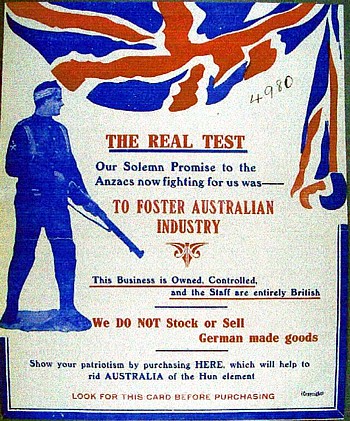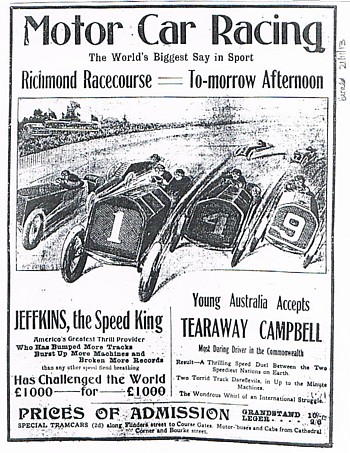 Later in February Jeffkins began a tour of NSW and Queensland with the Indianapolis film and commentary show commencing with a three night engagement in the Sydney Town Hall. These exhibitions proved enormously popular in Newcastle and surrounding districts with publicity noting that Jeffkins was born and raised in nearby East Maitland. The tour concluded in Queensland nine months later. (25)
Later in February Jeffkins began a tour of NSW and Queensland with the Indianapolis film and commentary show commencing with a three night engagement in the Sydney Town Hall. These exhibitions proved enormously popular in Newcastle and surrounding districts with publicity noting that Jeffkins was born and raised in nearby East Maitland. The tour concluded in Queensland nine months later. (25)
 During June 1915 Jeffkins announced in The Referee sporting newspaper that he had secured a ten year lease on a property just seven minutes drive from the Sydney GPO. Plans for the track development had been approved by the City Council and Jeffkins claimed that it would be “the fastest in the world”. Nothing further was heard of this venture. (26)
During June 1915 Jeffkins announced in The Referee sporting newspaper that he had secured a ten year lease on a property just seven minutes drive from the Sydney GPO. Plans for the track development had been approved by the City Council and Jeffkins claimed that it would be “the fastest in the world”. Nothing further was heard of this venture. (26)
 With the Great War in full swing there was a great swell of patriotism at this time together with a strong anti-german feeling across all facets of business. In an effort to promote and foster this sentiment, Jeffkins designed a placard for businesses to display in their shop windows promoting Australian industry. The sign also advised prospective customers that the business did not stock or sell German made goods. Copyright for the design of the card was issued to Jeffkins by the Commonwealth of Australia on 26th May 1916. (27)
With the Great War in full swing there was a great swell of patriotism at this time together with a strong anti-german feeling across all facets of business. In an effort to promote and foster this sentiment, Jeffkins designed a placard for businesses to display in their shop windows promoting Australian industry. The sign also advised prospective customers that the business did not stock or sell German made goods. Copyright for the design of the card was issued to Jeffkins by the Commonwealth of Australia on 26th May 1916. (27)
 During November 1916, Jeffkins was contracted by Marcus Clark and Company – the agents for Grant motor cars – to drive one of their six cylinder models from Sydney to Melbourne and return. As a further demonstration of the reliability of the model it was decided to run the engine non stop for the total duration of the week long journey. The trip was undertaken with Jeffkins and three passengers on board. The Sydney to Melbourne leg was uneventful, but the return leg was held under the most atrocious conditions with torrential rain and high winds for the whole distance. The Grant performed perfectly with the only mechanical problem a damaged front spring. The engine was not switched off during the week long journey. (28)
During November 1916, Jeffkins was contracted by Marcus Clark and Company – the agents for Grant motor cars – to drive one of their six cylinder models from Sydney to Melbourne and return. As a further demonstration of the reliability of the model it was decided to run the engine non stop for the total duration of the week long journey. The trip was undertaken with Jeffkins and three passengers on board. The Sydney to Melbourne leg was uneventful, but the return leg was held under the most atrocious conditions with torrential rain and high winds for the whole distance. The Grant performed perfectly with the only mechanical problem a damaged front spring. The engine was not switched off during the week long journey. (28)
 Since his return from America Jeffkins had held a long term desire to be involved in the manufacture of an all Australian built motor car. In July 1917 a Company was formed – The Roo Motor Car Manufacturing Company – with offices in Pitt Street Sydney and a factory located on a three acre site at Burwood. The Principals of the Company were Bill Foulis – the Chief Engineer, Thomas Lawton – a Director and Jeffkins – the designer and General Manager. It was planned to build only the one model - a standard two seater passenger roadster which was to sell for 195 pounds – the same price as a T model Ford. Unlike the other Australian makes, the Roo was designed, manufactured and assembled in their Sydney plant. It had a horizontally opposed two cylinder motor with spun copper water jackets. The clutch was a multi-disc unit running in oil and it had a compact three speed gearbox. The footbrake operated on a large brake drum mounted at the rear of the gearbox. A pointed radiator, underslung chassis and detachable wire wheels gave the Roo
Since his return from America Jeffkins had held a long term desire to be involved in the manufacture of an all Australian built motor car. In July 1917 a Company was formed – The Roo Motor Car Manufacturing Company – with offices in Pitt Street Sydney and a factory located on a three acre site at Burwood. The Principals of the Company were Bill Foulis – the Chief Engineer, Thomas Lawton – a Director and Jeffkins – the designer and General Manager. It was planned to build only the one model - a standard two seater passenger roadster which was to sell for 195 pounds – the same price as a T model Ford. Unlike the other Australian makes, the Roo was designed, manufactured and assembled in their Sydney plant. It had a horizontally opposed two cylinder motor with spun copper water jackets. The clutch was a multi-disc unit running in oil and it had a compact three speed gearbox. The footbrake operated on a large brake drum mounted at the rear of the gearbox. A pointed radiator, underslung chassis and detachable wire wheels gave the Roo
a pleasing appearance.
 The prototype was built during July and August 1917 and at noon on 12th September the car with Jeffkins and Foulis on board set off on a trial run to Melbourne and return. In spite of encountering some of the worst weather seen for years, the little car completed the return journey with no major problems. On good stretches the car averaged 20 mph and the fuel consumption worked out at a very economical 45 to 50 mpg. The journey was made with several detours to visit major towns off the direct route. One of the features of the trip was the great interest which the local residents displayed in the car with people often travelling many miles just to get a glimpse of the “Roo”. After arriving back in Sydney the Roo – in its travel worn state was displayed in the windows of David Jones’ George Street store.
The prototype was built during July and August 1917 and at noon on 12th September the car with Jeffkins and Foulis on board set off on a trial run to Melbourne and return. In spite of encountering some of the worst weather seen for years, the little car completed the return journey with no major problems. On good stretches the car averaged 20 mph and the fuel consumption worked out at a very economical 45 to 50 mpg. The journey was made with several detours to visit major towns off the direct route. One of the features of the trip was the great interest which the local residents displayed in the car with people often travelling many miles just to get a glimpse of the “Roo”. After arriving back in Sydney the Roo – in its travel worn state was displayed in the windows of David Jones’ George Street store.

 During the following months, a second car was built and a third was underway when the financial backers decided to pull out causing the collapse of the venture. In hindsight, the major factor in the demise of the project was the Principals ambitious decision to manufacture all the components ‘in house’. This coupled with the wartime shortage of raw materials proved to be too much to overcome. By August 1918 the Roo partnership had been dissolved. (29)
During the following months, a second car was built and a third was underway when the financial backers decided to pull out causing the collapse of the venture. In hindsight, the major factor in the demise of the project was the Principals ambitious decision to manufacture all the components ‘in house’. This coupled with the wartime shortage of raw materials proved to be too much to overcome. By August 1918 the Roo partnership had been dissolved. (29)
Rupert Jeffkins...continued.



